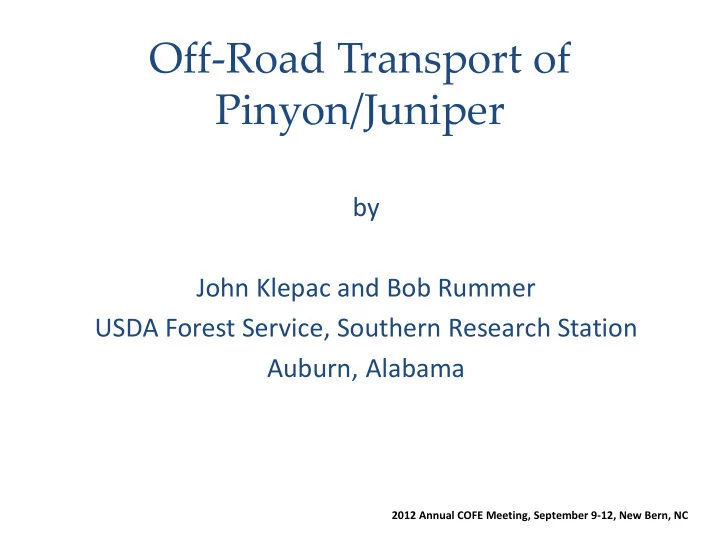

Off-Road Transport of Pinyon/Juniper by John Klepac and Bob Rummer USDA Forest Service, Southern Research Station Auburn, Alabama 2012 Annual COFE Meeting, September 9-12, New Bern, NC
Outline • Background • Study site and operation • Study methods • Results • Costs • Conclusions 2012 Annual COFE Meeting, September 9-12, New Bern, NC
Background Over the last 150 years PJ woodlands have expanded tenfold and occupy • 60M acres (Miller and Tuasch, 2001) Increase in density per acre and expansion of range of species • Typical treatments for restoring ecological values – burning, lop-and-scatter, • and firewood utilization 2012 Annual COFE Meeting, September 9-12, New Bern, NC
Potential Biomass Resource • PJ accounts for about 1/3 of available woody biomass (7.5 to 11.5M dry tons per year) in the western US (Skog et al. 2008) • More than any other single woody feedstock in the region 2012 Annual COFE Meeting, September 9-12, New Bern, NC
Barriers to Realizing Potential Utilization 1) Reducing cost of harvest and processing 2) Finding conversion processes that are compatible with properties of this material 2012 Annual COFE Meeting, September 9-12, New Bern, NC
Historical Data 1) Felling, skidding, and chipping PJ - $70/dry ton (Western Governor’s Association Report) 2) Grapple skidder and front-end loader – 6 green tons/hr at $7/green ton (Baughman, 2004) 3) Grapple skidders working in western juniper in Oregon - 3.8 to 4.9 green tons/hr at $11.50/ton (The Yankee Group) 4) Felling, skidding , and delimbing JUOS - $30 to $60/green ton at 450 ft (Dodson, 2010) 2012 Annual COFE Meeting, September 9-12, New Bern, NC
Objective of Project Evaluate the performance, productivity, and cost of a large capacity forwarder moving PJ biomass from a woodland restoration treatment to a landing. 2012 Annual COFE Meeting, September 9-12, New Bern, NC
Forwarder Operation Travel empty – Bunk first 2012 Annual COFE Meeting, September 9-12, New Bern, NC
Forwarder Operation 2012 Annual COFE Meeting, September 9-12, New Bern, NC
Methods (Travel distances) Garmin V GPS • Travel empty • Intermediate travel • Travel loaded 2012 Annual COFE Meeting, September 9-12, New Bern, NC
Methods (Time Study Analysis – Timer Pro) 2012 Annual COFE Meeting, September 9-12, New Bern, NC
Methods (Modeling of Elements) • General Linear Models Procedure (GLM) (SAS Institute Inc., 1988) • Travel time = f(dist) • Load and unload time = f(swings, pieces) 2012 Annual COFE Meeting, September 9-12, New Bern, NC
Methods (Soil Survey) Point transect method • (McMahon, 1995) 50 x 20 ft grid • 5 disturbance classes • Undisturbed Trafficked w/litter in place Trafficked w/mineral soil exposed Dragged Deeply disturbed 2012 Annual COFE Meeting, September 9-12, New Bern, NC
Results (Elemental Times) Percent of Total Cycle Time • 32% traveling 60 50 40 • 54% loading Percent 30 20 • 14% unloading 10 0 Travel Load Int. travel Travel Unload Move empty loaded unload Element 2012 Annual COFE Meeting, September 9-12, New Bern, NC
Treated Area 2012 Annual COFE Meeting, September 9-12, New Bern, NC
Cost Summary Cost = $91.53/PMH $/acre $/green ton 0.42 ac/hr 12.1 tons/hr $218/acre $7.56/ton 2012 Annual COFE Meeting, September 9-12, New Bern, NC
Results (Productivity) Ponsse Forwarder 9.50 9.00 $/green ton 8.50 8.00 7.50 7.00 300 500 700 900 1100 1300 1500 1700 Total distance (ft) 2012 Annual COFE Meeting, September 9-12, New Bern, NC
Conclusions • Forwarder concept is a relatively simple approach to reducing extraction costs • Loading time was dominate • Bunching material could enhance productivity and reduce cost per ton, but comes at the cost of felling productivity • Forwarder is less sensitive to extraction distance which allows treatments over larger units with fewer roads and landings 2012 Annual COFE Meeting, September 9-12, New Bern, NC
Acknowledgements • Bloomin Ranch Service/Southern Utah Biomass Organization • Bureau of Land Management – Cedar City Field Office • Miller Timber Services, Inc. • Ponsse 2012 Annual COFE Meeting, September 9-12, New Bern, NC
Thank You! 2012 Annual COFE Meeting, September 9-12, New Bern, NC
Recommend
More recommend